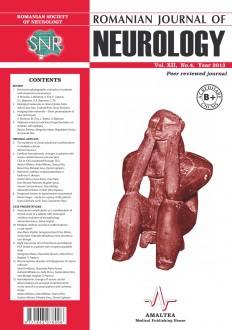SELECT ISSUE

Indexed

| |

|
|
|
| |
|
|
|

|
|
|
|
|
|
| |
|
|
HIGHLIGHTS
National Awards “Science and Research”
NEW! RJN has announced the annually National Award for "Science and Research" for the best scientific articles published throughout the year in the official journal.
Read the Recommendations for the Conduct, Reporting, Editing, and Publication of Scholarly work in Medical Journals.
The published medical research literature is a global public good. Medical journal editors have a social responsibility to promote global health by publishing, whenever possible, research that furthers health worldwide.
CEREBRAL HEMODYNAMIC CHANGES IN PATIENTS WITH SEVERE CAROTID STENOSIS PRE AND POST CEA OR CAS MONITORED THROUGH TCD
Marius Militaru, Anda Militaru, Stanca Ples, Raoul Pop, Mihaela Simu and Daniel LIGHEZAN
ABSTRACT
Purpose. We have tried to emphasize the hemodynamic changes that occur in patients who experience uni/bilateral symptomatic/asymptomatic severe carotid stenosis with acute or chronic ischemic stroke pre and post interventional (endarterectomy/stent) using TCD (Transcranian Doppler ultrasound) to determine BHT(breath holding test) and CVR (cerebrovascular reactivity) calculation.
Material and methods. 30 patients with severe carotid stenosis over 70% have been evaluated for the following endarterectomy (CEA) or stent placement (CAS). The Transcranial Doppler (TCD) was performed prior to surgery, at 72 hours and at 2 months after the intervention. Average flow velocities at middle cerebral artery (MCA) and pulsatility index (PI) ipsi/contralateral stenosis were recorded. CVR through the apnea test (BHT) was measured, recording an increase in the mean fl ow velocity and calculating MCA-BHI (breath-holding index) of ipsi and contralateral stenosis.
Results. Mean flow velocities (MFV) in the middle cerebral artery (MCA) have significantly increased both ipsilateral to stenosis from 31.01 +/-5.81cm /s prior to surgery, from 40.75 +/-7.53 cm / s (p <0.01) at 72 hours postCEA/CAS, as well as contralateral to stenosis, from 36.09 +/-6.49 before surgery to 42.31 +/-7.50 postintervention, and pulsatility index (PI) significantly increased ipsilateral from 0.72 +/-0.15 to 0.88 +/-0.12. (p <0.01) after both endarterectomy and after angioplasty and contralateral stent placement from 0.79 +/-0.16 to 0.97 +/-0.13 (p <0.01) in both postintervention studies (CEA/CAS) compared with presurgery carotid stenosis values. Mean flow velocities at MCA increased significantly 2 months after surgery both by CEA/CAS, with slightly better contralateral to carotid stenosis and after CAS. CVR (%/s) significantly increased statistically from 0.60 +/-0.58 to 0.85 +/-0.54 (p <0.05) postintervention, both at 72 hours postsurgery, and 2 months after surgery, both ipsi and contralateral to stenosis, both after endarterectomy and after stent.
Conclusions. Both endarterectomy and angioplasty with stent placement are interventional methods that produce significant increases in mean flow velocities in the MCA immediately after surgery, with improved cerebral parameters and cerebrovascular reactivity both ipsi and contralateral to stenosis right after surgery, but especially at 2 months after surgery. CVR had a significant statistical increase after endarterectomy or stent, with no difference between 72 hours and 2 months post intervention at ipsilateral and contralateral increases were significant, but with higher values at 72 hours (p <0.01) compared to 2 months (p <0.05), with slightly better ipsilateral to carotid stenosis at 2 month, regardless of the carotid atheromatosis degree contralateral to severe carotid stenosis.
Keywords: carotid stenosis > 70%; transcranian Doppler – breath-holding test, cerebrovascular reactivity, endarterectomy/stent
